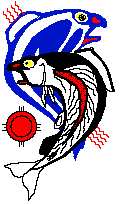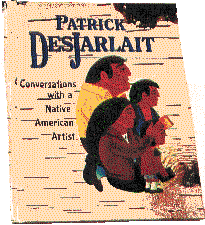



Page Navigation Buttons--- |
|---|
|
As a little boy growing up on the Red Lake Indian Reservation, he was called Na-gwa-bo -- Boy in the Woods. He was given this name because he could always be found in the woods, always alone, and either quietly sketching or thinking. Patrick DesJarlait found beauty in his surroundings. He found beauty in the faces of his people. He found beauty in their way of life. He found beauty where he was not supposed to find it. In boarding school, where his Indian name was taken away, his teachers told him repeatedly there was no value in an Indian way of life. He did not listen. He continued to sketch the woodlands, the animal-beings and the people he came to know so well. The DesJarlait family consisted of his parents and four brothers and two sisters. Patrick's father worked as a woodcutter for the Red Lake Lumber Mill. His mother died when he was seven. After this very sad event in his life, he spent much of his time in boarding schools at Red lake and Pipestone, Minnesota. He did not begin to think seriously of taking up a career in art until he entered higfh school. At Red Lake High School, he became a student of Miss Ross, an English teacher. She encouraged his interest in art. She even purchased special supplies for him on her trips to the cities. After graduating from high school,, Patrick got a scholarship to study art at Arizona State College in Phoenix. A year later, during World War II,m he entered the government service. He was sent to teach an art workshop at a nearby Japanese Relocation Camp. When the U.S. declared war on Japan in 1941, Japanese Americans were taken from their homes and moved to special prison camps. They had done nothing wrong but in the months that followed the declaration of war, Americans bnecame panicky. They demanded that Japanese Americans be carefully watched. Too, many of these families had developed fine farmland or stores, mostly in California. Their properties were seized and sold. Patrick felt sorry for these people. Their plight reminded him of what had happened to his own people a century earlier. Months later, he joined the Navy and was assigned to a naval base in San Diego, California. Here he worked with artists from Walt Disney Studios creating films for the Navy. When the war ended, Patrick returned home to the Red Lake Reservation. Here he completed what was to become his favorite painting. He called his watercolor "The Red Lake Fisherman". He felt this painting brought together all the artistic concepts he had been working so hard to perfect. At the same time, his painting captured an important part of the way of life of the Red Lake people. In this and subsequent paintings, the influence of the Spanish artist Pablo Picasso, and the Mexican muralist Diego Rivera can be seen. He considered both men to be great artists. |
|---|
Bio continued after picture insert.




|
I don't have a copy of DesJarlait's favorite Red lake Fishermai painting. But Patrick did two paintings around the same time in a similar style that were bought by a Tulsa museum.
Robert's curved trees that make a formal pattern, the still, soft snow, the circular focus, all convey the sacred, timeless, spiritual aspect of this food. Families who traditionally prepared sugar as an important food would have a "900-tap bush" on the average, but some larger families might sugar from a bush of up to 3,000 maple taps. That's no longer possible, there aren't enough maple trees left. Maple sugaring is still done at Mille Lacs and a few other places. In this 1946 photo (which I false-colored) the Martin Kegg family is shown sugaring at Mille Lacs. Today sugaring is done mostly by Indian youth, under the guidance of several elders, such as Walter "Porky" White. Traditional stories are told at night in the camp, and everyone has fun as well as working. This traditionally-made real maple syrup is sold in jugs to raise funds for Indian organizations, or is used at big pancake breakfasts. To anyone who has tasted the real thing, syrups sold in stores (made from corn sugar and chemicals) are pitiful, tasteless. Both DesJarlait artists, father and son, have captured for us a true "taste of the woods".
|
|---|
|
    From Red Lake, the DesJarlait family moved to the Twin Cities. Patrick found employment as a commercial artist. His experience in helping to create animated films for the navy began to serve him sell. He was selected to help create an animated television commercial for Hamm's Brewery. Soon, the comical and gentle Hamm's bear he created became a familiar part in the lives of television audiences of the 1950's. He thought of his bear as "One of the most delightful accomplishments I've had in commercial art." During his 26-year career as a commercial artist, his work was always in demand. The art and business community alike recognized him as a very versatile artist. He could do fine art, commercial art and even very technical drawings. Patrick DesJarlait got a chance to pursue his real dream during the last few years of his life. He wanted to combine art with education. His dream was to teach non-Indian people aboujt the beauty and dignity of the Ojibway traditions. With this dream in mind, he traveled throughout Minnesota talking to students about art. His passion for art began to affect his children. Three of the five DesJarlait children are actively engaged in art careers. His oldest son, Robert, finds comfort in the fact that his father was able to realize his dream. "Through art," Robert says, "my father found a way of giving something back to his people." .    
Wanted: Color stills from Patrick DesJarlait's 1955 Hamm's beer TV commercial "FRUHhum-m-m-m the LA-A-A-nd of SKYBLUE wah-HA-ters..." showing the bear that Patrick liked so much |
|---|
 A book about Patrick's life -- and Indian family life on the Red Lake Ojibway Indian reservation, in the old days and through the '70's -- is available and highly recommended for Native schools and all schools with multicultural social studies or art education programs. It has been favorably reviewed by School Library Journal and Booklist of the American Library Association.
A book about Patrick's life -- and Indian family life on the Red Lake Ojibway Indian reservation, in the old days and through the '70's -- is available and highly recommended for Native schools and all schools with multicultural social studies or art education programs. It has been favorably reviewed by School Library Journal and Booklist of the American Library Association.
Patrick DesJarlait: Conversations with a Native American Artist, 56 pages, $21.50; Runestone Press, Lerner Learning Group Publishers, Minneapolis, 800/328-4929. Lerner discounts 25% to school purchasers on its hardcovers. There is a Canadian distributor, too. Grade/reading level: 5+. Call for their free, extensive catalog. They carry many authentic and attractive Native American books for elementary and high school, as well as attractive school supplementary books on all subjects, for all grade levels. Many parents who want their children to learn about other cultures will find many beautiful books here pertinent to African-Americans, and immigrant groups, as well as Lerner's Native series: "We're Still Here: Native Americans Today."
In this first-person narrative, recorded before his death in 1972, Patrick tells of his boyhood as a reservation Indian on the Red Lake Ojibwe reservation of northern Minnesota. He describes his experiences in art school, his artistic work for the Navy, and his start and progess as a highly successful commercial artist, as well as his inspirations and goals in fine art. This book is thus well suited both for social studies -- Native life and work -- and for art students.
This is a new edition of a book Lerner published shortly after his death, from tapes made by Neva Williams. The new edition is 8 x 10". It now contains many more full-color reproductions of his paintings. (The cover, shown here, is a cutout from one of his watercolors, "mounted" on birch bark.) The manuscript has also been supplemented with many large, clear black and white historical photos depicting traditional Ojibwe reservation life in the pre-World War II period (and earlier). Patrick's own paintings show many aspects of the daily round of traditional life -- as his maple sugaring and wild rice processing paintings do here. These convey what's really happening in those activities, but they are also works of art, in his clear, bold style. The new edition also treats DesJarlait as a worthy member of the tradition of world-wide artists generally -- as well as Native artists, who usually are put in a kind of ghetto or "museum" away from the broader world of art, of which their creative works are really a part.

Custom Search
|
 TOP of TOP of Page |
 ART ART MENU |
 MAIN MAIN MENU |
|---|
|
Explanatory text and graphics copyright 1995. |
|---|
Last Updated: Tuesday, February 20, 1996 - 1:03:30 PM